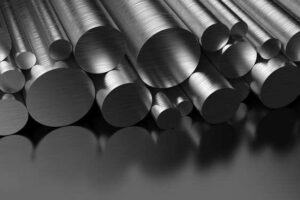Tool Steel for Plastic Molding: Requirements and Material Selection
Introduction
Tool steels are widely used for constructing injection molds, blow molds, compression molds, and other tooling used for plastic molding processes. The steels need to withstand the pressures, temperatures, and corrosive conditions involved while maintaining dimensional accuracy.
This article explores the demanding requirements of plastic molding tool steels. It provides guidance on selecting optimized grades based on factors like mold complexity, production volumes, plastic materials being molded, and required mold finish. Heat treating considerations are discussed along with recommendations for surface treatments or coatings to maximize mold life and performance.
Overview of Plastic Molding Processes
 Common plastic molding techniques utilizing tool steel molds include:
Common plastic molding techniques utilizing tool steel molds include:
- Injection molding – Most prevalent process; polymer injected into mold at high pressure
- Blow molding – Parison extruded and inflated against cavity mold walls
- Compression molding – Polymer placed in mold, compressed and shaped under heat/pressure
- Rotational molding – Mold rotated while powdered polymer melts and coats cavity
- Thermoforming – Plastic sheet heated and vacuum formed over single-sided mold
While the methods vary, each process imposes demanding thermal, mechanical, and chemical conditions on the tooling.
Challenges and Failures for Tool Steels in Plastic Molding
Typical failure modes and challenges include:
- Thermal fatigue cracking from repeated heating/cooling cycles
- Loss of dimensions from plastic deformation under molding pressures
- Abrasive wear from glass or mineral filled polymers
- Adhesion and tearing from poor mold finish or release properties
- Corrosion from aggressive plastic resin additives
- Degradation of surface finish over prolonged use
Selecting the proper tool steel and applying appropriate enhancements minimizes these issues for longest mold life.
Desired Properties for Plastic Molding Tool Steels
The ideal characteristics for plastic molding tool steels are:
- High hardness to resist wear, deformation, and absorption of plasticizers
- Good ductility and impact toughness to prevent cracking
- Dimensional stability during heating/cooling cycles
- Excellent polishability and surface finish for mold detail reproduction
- Some corrosion resistance for protection from chemical additives
- Ease of texturing for imparting required surface effects
Achieving the optimal balance of these properties maximizes durability and performance over thousands of molding cycles.
Tool Steel Selection Guidelines
Recommended selections based on mold complexity include:
Low Complexity Molds
- P20 modified tool steel provides good polishability and texturing response at low cost
Medium Complexity Molds
- H13 hot work tool steel delivers better wear resistance and stability
- 420 stainless steel adds corrosion resistance
High Complexity Molds
- Premium grades like P20+ or 420+ with additional alloys for further enhancements
- Powder metallurgy tool steels allow very high hardness with good toughness
Matching mold steel to requirements ensures adequate properties at reasonable cost.
Key Tool Steel Considerations for Specific Plastics
Polymer type also influences tool steel selection:
Commodity Resins – P20 or 420 grades offer sufficient performance
Engineering Resins – H13 provides increased wear and heat resistance
Reinforced Polymers – Premium grades resist abrasive fillers
Corrosive Plastics – Additional chromium in 420 or nitriding/coating provides protection
High Temperature Polymers – Hot work tool steel maintains properties and finish
Pairing the tool steel to the plastic molded gives optimal results.
Heat Treating Tool Steels for Plastic Molds
Proper heat treatment of mold tool steels requires:
- Sufficient austenitizing temperature to dissolve carbides
- Rapid oil quenching to form fully hardened martensite
- Low temperature tempering at 300-400°F range to maximize hardness
- Double or triple tempering to impart needed impact resistance
- Slow cooling from final temper to preserve beneficial compressive stresses
The goal is very high hardness along with ductility to prevent brittle cracking under molding stresses.
Tool Steel Surface Treatments and Coatings

Surface enhancements prolong mold life and improve performance:
- Nitriding – Develops a very hard, corrosion resistant case
- PVD Coatings – Improve wear life, lower friction, and prevent plastic adhesion
- Electropolishing – Smooths surface for easier mold release and improved finish
- Laser Texturing – Creates micro patterns to eliminate sticking
Applied selectively to high wear areas, these treatments can significantly extend mold life.
Manufacturing Methods for Enhanced Properties
State-of-the-art tool steel production methods provide benefits:
- Vacuum Processing – Improves cleanliness and densification
- Powder Metallurgy – Achieves very homogeneous, fine grained microstructures
- Metal Injection Molding – Allows combining complex geometric shapes with high performance
- Additive Manufacturing – Permits tailored conformal cooling designs to be incorporated
Capitalizing on these technologies maximizes plastic molding tool steel properties and performance.
Mold Maintenance Best Practices
Proactive mold maintenance also prolongs life:
- Periodic inspection for wear, erosion, cracking, or distortion
- Re-polishing or re-texturing of impression surfaces to restore finish
- Minor repairs to correct small defects before they propagate
- Dimensional restoration to correct plastic deformation issues
- Reapplication of coatings or surface treatments in high wear areas
Effective maintenance paired with optimized tool steel selection enables hundreds of thousands of trouble-free molding cycles.
Summary
The key guidelines for tool steels in plastic molds are:
- Match the mold steel grade to the mold complexity and plastic being molded
- Utilize grades offering the best polishability, hardness, and toughness balance
- Apply appropriate coatings and surface treatments to enhance durability
- Incorporate advanced manufacturing methods to further improve properties
- Implement sound mold maintenance practices between production runs
Following these practices allows mold tool steels to withstand the pressures, heat, corrosion, and wear of plastic molding to produce high quality components over long lifetimes.
Frequently Asked Questions
What key property differences exist between hot work and cold work tool steels for molding?
Hot work tool steels like H13 better retain their hardness and dimensional stability at the elevated molding temperatures required for engineering resins. Cold work steels lose some hardness and are more prone to plastic deformation issues under high molding pressures.
How does powder metallurgy tool steel improve mold performance compared to conventional wrought grades?
The fine, uniform carbide sizes and distributions in PM tool steels increase hardness while also improving fracture resistance. This allows better wear properties without sacrificing ductility or toughness likemono riCcio Bio in hardened wrought alloys.
What recent surface enhancement options show the most promise for improving mold life?
Advanced PVD coatings and laser surface texturing methods enable significant improvements in wear resistance, mold release, and restoration of surface finish in high wear areas of molds.
How do factors like production volumes and mold complexity influence tool steel selection?
Higher complexity molds needing tighter dimensional control or improved wear resistance justify use of more sophisticated premium tool steel grades. For lower complexity shapes, value grades perform adequately.
What heat treating processes pose the biggest challenges for mold tool steels?
Achieving very high hardness through martensitic quench hardening while avoiding brittleness or distortion issues can require rigorous process control. Proper tempering is also critical to balance needed hardness and toughness.
Please let me know if you have any other questions!

